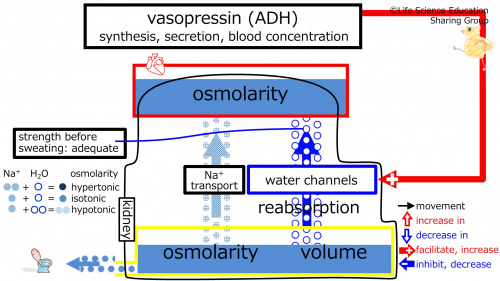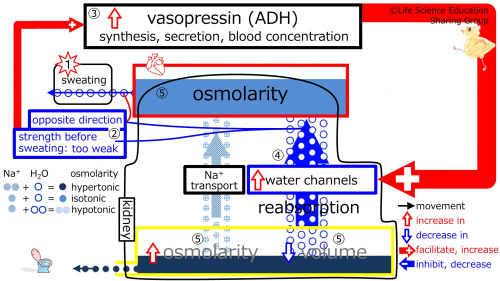Endocrinology/VasopressinADH/ControlToSweating
| With sweating, plasma osmolarity increases, and negative feedback increases the synthesis, secretion, and concentration in blood, of vasopressin (anti-diuretic hormone, ADH). |
Before sweating, there are 3 columns (illustration) of water reabsorption (water entering the plasma through the water channels, that are increased by vasopressin, ADH, which has certain levels of synthesis, secretion, and concentration in blood), as well as 3 columns of Na+ reabsorption (by the Na+ pump). Plasma and urine osmolarity are normal (isotonic).
1st star (illustration): With sweating, water leaves the plasma, and plasma osmolarity increases (becomes concentrated, hypertonic).
Movement of water with sweating is in the opposite direction of water reabsorption (water entering the plasma, through the water channels, that are increased by vasopressin, ADH).
②-1 (illustration): Because the movement of water (leaving the plasma) with sweating and with water reabsorption (water entering the plasma, through the water channels, that are increased by vasopressin, ADH) are in the opposite direction, the negative feedback increases (the synthesis, secretion, and concentration in blood, of) vasopressin (ADH).
②-2 (illustration): The water channel-increasing effect of vasopressin (ADH) strengthens, and the number of water channels increases.
②-3 (illustration): With the increase in water channels, water reabsorption from the tubule increases from 3 to 4 columns (illustration).
③(illustration): With no change in Na+ reabsorption, and the increase in water reabsorption, diluted (hypotonic) fluid enters the plasma. Because of this control, the increased plasma osmolarity decreases (towards that before sweating, or isotonicity). Namely, the initial change (the increase in plasma osmolarity) decreases (red upward unfilled arrow disappears).
Because diluted (hypotonic) fluid (of 3 columns of Na+ and 4 columns of water) leaves the tubule with reabsorption, the osmolarity of the fluid remaining in the tubule (urine) increases (becomes concentrated, hypertonic). Also, with the increase in water reabsorption (water leaving the tubule), the volume of water remaining in the tubule (urine) is less. Overall, the urine becomes concentrated and decreases in volume.
Challenge Quiz
With sweating, the plasma osmolarity increases, and negative feedback increases decreases the synthesis, secretion, and concentration in blood, of vasopressin (anti-diuretic hormone, ADH).
With sweating, the plasma osmolarity increases decreases . This is in the same direction as opposite direction to the plasma osmolarity-increasing osmolarity-decreasing effect of the water reabsorption from the tubule (through the water channels, that are increased by vasopressin, ADH). The negative feedback increases decreases (the synthesis, secretion, and concentration in blood, of) vasopressin (ADH). This will increase decrease plasma osmolarity (returning to isotonic).
With sweating, water enters leaves the plasma and osmolarity increases decreases .This is in the same direction as opposite direction to the plasma osmolarity-decreasing effect of the water reabsorption (through the water channels, that are increased by vasopressin, ADH). Thus, although the strength of the plasma osmolarity-decreasing effect of water reabsorption (through the water channels, that are increased by vasopressin, ADH) was too weak adequate too strong before sweating (at baseline), this strength is now too strong adequate too weak to reverse the increased decreased plasma osmolarity produced by sweating. The negative feedback increases decreases (the synthesis, secretion, and concentration in blood, of) vasopressin (ADH). The water channel-increasing effect of vasopressin (ADH) becomes stronger weaker , which increases decreases the number of water channels. With the increase decrease in water reabsorption from the tubule, concentrated diluted solution enters the plasma. This will lead to a reverse in increased decreased plasma osmolarity from sweating, increasing decreasing it towards separate from normal (baseline) osmolarity. Because concentrated diluted solution leaves the tubule due to reabsorption, the fluid remaining in the tubule has an increased a decreased osmolarity. Also, with the increase decrease in water reabsorption, there is more less water remaining in the tubule. Overall, the urine becomes concentrated diluted and increases decreases in volume.




